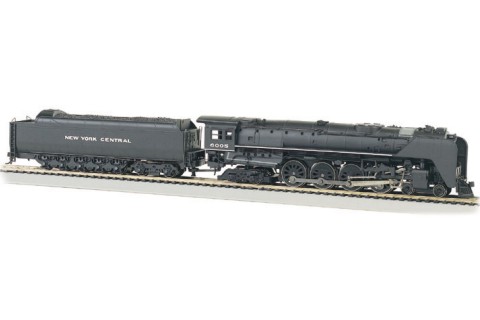

4-8-4 Niagara
The answer was a 4-8-4 with 30% more tractive effort (61,500 lbs) and 25% more grate area (100 sq ft), a weight of 471,000 lbs and a 6000 HP rating. This locomotive's design included 25.5 x 32 cylinders, 275 lbs psi boiler pressure, 79" drivers and roller bearings on all axles, coupling rods and connecting rods.
The American Locomotive Company was given the order and delivered the first 4-8-4, Class S-1a, in 1945. The new locomotive was given road number 6000 in keeping with the design goal of 6000 HP. The NYC had 4-8-2's called "Mohawks" named after a river and 4-6-4's called "Hudsons" named after another river. It completed its passenger motive fleet with the new 4-8-4s which it called "Niagaras" after a third New York river.
The indicated (i.e. cylinder) HP of the Niagaras were 6680 at 85 mph. The maximum drawbar HP was 5070 for the S-1b at 62.5 mph (Niagara #6023 was tested). The complete dynomometer test report from this over-the-road testing, which was conducted per industry standards, and contains this documentation, is available from the New York Central System Historical society.
In 1946, The American Locomotive Company delivered 25 Class S-1b Niagaras. Locomotives 6001 through 6019 were built in October through December of 1945. Locomotives 6020 through 6022 were built in January of 1946, and locomotives 6023 through 6025 were built in April of 1946. One other, number 5500, was equipped with poppet valves and designated Class S-2a.
The Niagaras handled the twelve daily New York to Chicago passenger trains including "The Chicagoan", "The Commodore Vanderbilt" and "The Empire State Express".
There was an almost forgotten earlier 4-8-4 built in 1931 by ALCO. This three-cylinder experimental locomotive carried road number 800 and was designated Class HS-1a. It did not do well on its test runs and was put to work as a hump engine at Selkirk yard.
There are no surviving NYC "Niagaras" which is especially disappointing because these 4-8-4s were head and shoulders above any other Northern in the areas of boiler and drawbar horsepower. They were also better than any steam locomotive in the areas of weight per HP, availability, monthly and annual mileage, and total life cycle cost.
| Class | Road Numbers | Year Built | Builder |
|---|---|---|---|
| HS-1a | 800 | 1931 | ALCO |
| S-1a | 6000 | 1945 | ALCO |
| S-1b | 6001-6019 | October-December 1945 | ALCO |
| S-1b | 6020-6022 | January 1946 | ALCO |
| S-1b | 6023-6025 | April 1946 | ALCO |
| S-2a | 5500 | June 1946 | ALCO |
| Specifications for Class S-1b | |
|---|---|
| Wheel Arrangement: | 4-8-4 |
| Length: | 115' - 5.5" |
| Drivers: | 79" dia. |
| Weight on Drivers: | 275,000 lbs |
| Total Locomotive Weight: | 471,000 lbs |
| Locomotive & Tender Weight: | 891,000 lbs |
| Grate Area: | 100.1 sq ft |
| Cylinders: | (2) 25.5" dia. x 32" stroke |
| Boiler Pressure: | 275 psi |
| Tractive Effort: | 61,500 lbs |
| Tender Capacity: | 18,000 gals of water and 46 tons of coal |